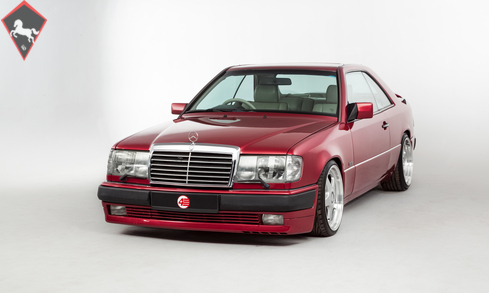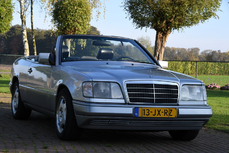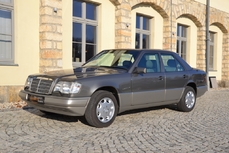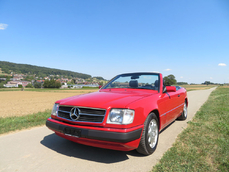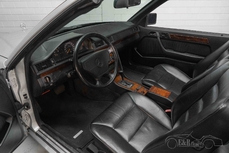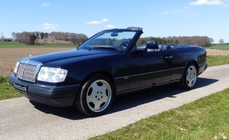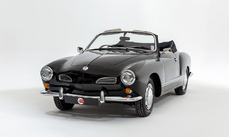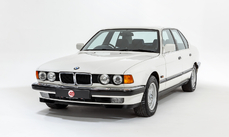Mercedes-Benz 300 w124 Carat Duchatelet 1992
General description :
Model History
W124 was the internal chassis designation for the 1984-1996 version of the Mercedes-Benz E-Class. It was also the first generation to be officially referred to as the E-Class. The W124 models replaced the W123 models after 1984 and were succeeded by the W210 E-Class after 1995.
Much of the 124's engineering and many of its features were advanced automotive technology at its introduction, incorporating innovations that have since been adopted throughout the industry. It had one of the lowest drag coefficients of any vehicle of the time due to its aerodynamic body, that included plastic molding for the undercarriage to streamline airflow beneath the car, thus reducing fuel consumption and wind noise. It had a single windscreen wiper with an eccentric mechanism at its base that extended the wiper's reach to the top corners of the windscreen (more than if it had traveled in a simple arc). The saloon, coupes, and convertibles had optional rear headrests that would fold down remotely to improve rearward visibility when required. This feature was not available for the ‘T’ model because there was no space to store the retractable headrests.
With the exception of the 200, fuel injection was standard throughout the range along with other performance-maximising technologies. The most notable feature was the addition of an oxygen sensor in the exhaust system, which in conjunction with a semi-electronic fuel injection system, could make the engine run more efficiently. This improved fuel consumption while simultaneously meeting stricter emission regulations.
The first C124 models to see the light of day were the 230CE and 300CE, followed by other versions such as the 200CE, 220CE, and 320CE, along with a new “Sportline” package introduced in 1989 together with the facelift. Later that year the flagship 300CE-24 joined the lineup with its six-cylinder engine producing 217hp.
Founded by Frederic Duchatelet in 1968, the Belgian company "Carat by Duchatelet" specialised in the elegant modification of Mercedes-Benz and Rolls-Royce motorcars. Duchatelet interiors were among the finest available in the 1980s and ‘90s, while exterior modifications were usually subtler than the ones from other coachbuilders of that time. Duchatelet had a good relationship with Mercedes-Benz who approved all of their conversions, including stretch-limousines.
Equipment
Carat Duchatelet special options: Special alloy wheels (not fitted), Full body styling including Carat Duchatelet spoiler, Carat Duchatelet leather steering wheel, Carat Duchatelet dials, Walnut gearshift knob, Walnut dash and door inlays; Automatic transmission, Sports Chassis, Electrically adjustable driver’s seat, Electrically adjustable passenger door mirror, Electric tilt and slide sunroof, Cruise control, Air Conditioning, Front armrest, Folding rear headrests, Tailored overmats, Headlamp wash/wipe, Spare alloy wheels, Mercedes first aid kit, Mercedes tool roll, Warning triangle, Jack, Spare key, 300 CE-24 rear badge (not fitted).
Exterior
This rare C124 Carat Duchatelet presents to an exceptionally high standard; it’s arrow-straight along both sides and completely free from any chips or major blemishes. The gleaming Almandine Red paint finish is second to none with a deep lustful shine, the only imperfections to note being a couple of small scrapes low down on front apron. All of the chrome and plastic trims are immaculate with no marks or sun damage, and the lights are crystal clear showing no signs of moisture ingress. This rare edition truly defies its age/mileage and would certainly make an excellent show car.
Interior
The cabin also presents beautifully, the leather retaining a soft matte finish free from wear to the bolsters and piping. All the door cards, plastic trims and dash are pristine, and the special Carat Duchatelet walnut inlays are perfect. The spotless carpets are fully protected with a nice set of piped overmats and the Carat Duchatelet steering wheel still appears fresh. All the controls have been checked and work as they should, the only non-standard item being a Pioneer head unit with Bluetooth capability. At the rear of the car the boot area is very clean with the spare wheel, warning triangle and jack all present and correct.
ENGINE & TRANSMISSION
The engine compartment is very clean and completely free of any corrosion; even the sound deadening on the underside of the bonnet remains in excellent condition. The car has been given a clean bill of health after its inspection, and with 21 stamps in the service booklet it has clearly been well maintained throughout its life. The mechanics of the car remain factory standard aside from the addition of an Ulter stainless steel exhaust, which sounds great.
WHEELS, TYRES & BRAKES
The Mercedes comes with two sets of alloys; the two-piece rims photographed are all in fantastic condition and are shod in nearly new tyres. Also available are the original Carat Duchatelet alloys in good condition but requiring tyres. The suspension has been upgraded recently with new shocks and springs that have lowered the ride height giving the car a more purposeful stance.
History File
The current owner has had the car for five years and there have only been four previous keepers. It has been maintained to an excellent standard with 15 main dealer Mercedes-Benz stamps and 6 specialist, all present in the original service booklet; the last service was carried out in March 2018 less than 1k miles ago. There is also a file full of invoices detailing every expenditure on the car right back to the late ‘90s along with every MOT certificate from 1998. The History File is complete with the original document pack, all owners’ manuals, a spare key, an original W124 brochure, and a Carat Duchatelet sales brochure.
http://www.4starclassics.com/for-sale/mercedes-300ce-24-carat-duchatelet-for-sale/
1992 Mercedes-Benz 300 w124 Carat Duchatelet is listed sold on ClassicDigest in Kingsley by 4 Star Classics for £9995.
Car Facts
Car type : Car Make : Mercedes-Benz Model : 300 w124 Model Version : Carat Duchatelet Engine size : 3.0 Model Year : 1992 Sub type : Sedan Location : Hampshire
Sold
Seller Information
Sold
People who viewed this Mercedes-Benz 300 w124 also viewed similar Mercedes-Benz listed at ClassicDigest
Other cars listed for sale by this dealer
About Mercedes-Benz
In the annals of automotive history, the journey of Mercedes-Benz is a tale that unfolds with the ingenuity of its founding pioneers. In the year 1886, Karl Benz crafted the Benz Patent Motorwagen, a creation that would go down in history as the world's inaugural automobile. Unbeknownst to him, this moment marked the genesis of what would evolve into the most illustrious premium car manufacturer globally. The financial underpinning of this pioneering venture, interestingly, was provided by Karl Benz's wife, Bertha Benz, demonstrating a remarkable partnership that would set the tone for Mercedes-Benz's legacy.A parallel narrative emerged not far away, as Daimler-Motoren-Gesellschaft, founded by Gottlieb Daimler and Wilhelm Maybach, entered the scene. In 1901, they unveiled their automobile under the now-famous moniker "Mercedes," meaning "godsend" in Spanish. This name was bestowed upon the car at the behest of Emil Jellinek's daughter, the distributor for Daimler-Motoren-Gesellschaft. The wheels of innovation were set in motion.
Fast forward to 1926, a pivotal year that witnessed the merger of Daimler with Benz & Cie., culminating in the birth of Daimler-Benz. The amalgamation saw the adoption of "Mercedes-Benz" as the distinguished trademark for their automobiles, fusing the legacies of two visionary entities into one.
Contrary to perceptions of conservatism, the trajectory of Daimler-Benz unfolds as a chronicle of industry firsts. From the introduction of the honeycomb radiator to the float carburetor, and the pioneering implementation of four-wheel brakes in 1924, Daimler-Benz consistently pushed the boundaries of automotive innovation. The diesel-powered Mercedes-Benz 260 D in 1936 marked the inception of diesel engines in passenger cars. The iconic Mercedes-Benz 300SL Gullwing made history as the first car with direct fuel injection, albeit the Gutbrod's tiny 2-stroke engine can claim precedence.
Safety innovations became a hallmark, with Béla Barényi's patented safety cell design in the "Ponton"-models in 1951, featuring front and rear crumple zones. The W116 450SEL 6.9 saw the introduction of the Anti-Lock Brake system (ABS), another pioneering safety feature. From the first production airbags and beyond, the legacy of "firsts" continued to be etched into the fabric of Daimler-Benz.
Over its centennial journey, Mercedes-Benz has not merely produced cars but has sculpted automotive icons. The SSKL, 710 SSK Trossi Roadster, 770K Grosser, 540K Spezial Roadster, 300SL Gullwing, w100 600 Pullman, w111 280SE 3.5 Flachkühler, w113 230SL Pagoda, w109 300 SEL 6.3, and w201 2.3-16 Cosworth stand testament to the brand's commitment to engineering excellence.
The roaring Silver Arrows, or "Silberpfeile," including the W 25, W 125, W154, W165, and W196, created a legacy of dominance on the racetrack. These machines were not merely cars; they were expressions of precision, speed, and an indomitable spirit that left their competitors in the dust.
As Mercedes-Benz marches into the future, it does so not just as an automaker but as a custodian of a legacy, a torchbearer of innovation, and a beacon of automotive excellence. The road ahead is sure to witness the continued fusion of cutting-edge technology, timeless design, and an unwavering commitment to setting new standards in the world of automobiles.
One luminary figure who left an indelible mark was Béla Barényi, often heralded as the "father of passive safety" for his pioneering work in safety engineering. His patented safety cell design, featuring front and rear crumple zones, became a hallmark of Mercedes-Benz's commitment to occupant safety, setting new standards that reverberated throughout the automotive world.
Moving through the chronicles, the collaborative genius of Wilhelm Maybach, alongside Gottlieb Daimler, laid the foundation for Daimler-Motoren-Gesellschaft. Their innovations not only birthed the first Mercedes but established a culture of relentless pursuit of technological excellence that remains integral to Mercedes-Benz's DNA.
In the post-merger era of 1926, Ferdinand Porsche emerged as a prominent figure within Mercedes-Benz. His work on the Mercedes-Benz S-Type, a supercharged race car, garnered acclaim and set the stage for a legacy that extended far beyond the marque. Porsche's impact would later extend to his eponymous company, but his influence at Mercedes-Benz during those formative years was pivotal.
As the 20th century progressed, the legendary Rudolf Uhlenhaut emerged as a key figure. Uhlenhaut, an accomplished engineer and the driving force behind the iconic Silver Arrows, played a crucial role in Mercedes-Benz's dominance in motorsports. His engineering prowess and attention to detail were instrumental in creating some of the most formidable racing cars of the era.
In the latter half of the century, figures like Bruno Sacco, the head of design at Mercedes-Benz from 1975 to 1999, left an indelible imprint on the brand's aesthetic identity. Sacco's design philosophy, characterized by clean lines and timeless elegance, shaped iconic models like the W126 S-Class and the W201 190E, solidifying Mercedes-Benz's reputation for luxury and sophistication.
The narrative would be incomplete without acknowledging the contributions of engineers like Hans Scherenberg, whose leadership in the 1970s ushered in a new era of technological innovation at Mercedes-Benz. Scherenberg's tenure saw the development of groundbreaking technologies, including the Anti-Lock Brake system (ABS) and the introduction of airbags in production cars.
